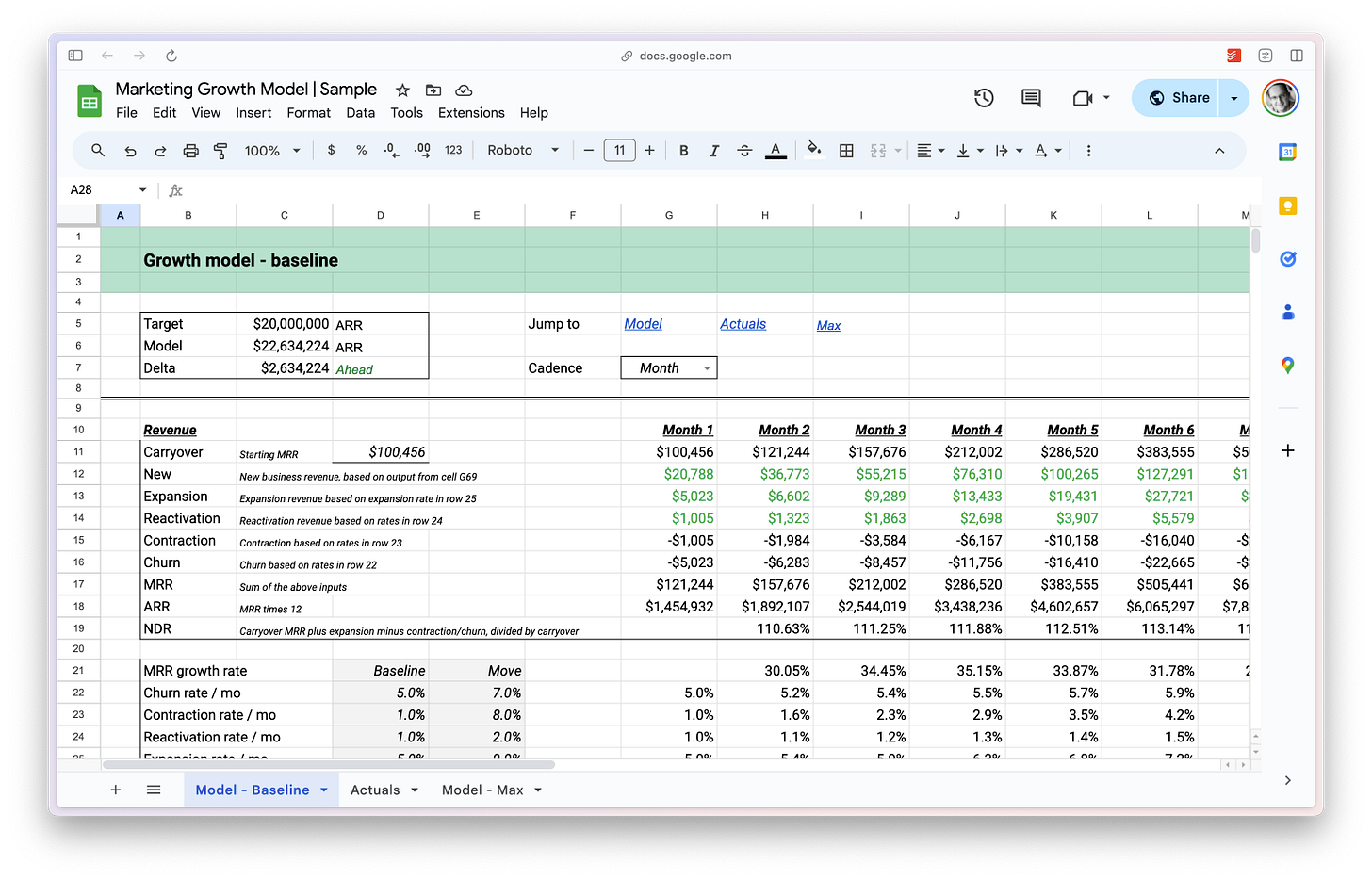I’m back after a prolonged hiatus break…with some personal news to share!
I am very happy to announce I’ve joined Meilisearch as a growth marketer. What excites me for this is not just the opportunity to deepen my growth expertise, but the ability to work with an amazing team on a great product!
Some time ago, I explained how you should think about growth systematically including how to put together a growth strategy.
Today, I am taking a step further into the rabbit hole to share the exact process I follow when I first start working on growth with a new team.
My process follows 3 steps:
Growth Audit: I start by examining the current setup and the running campaigns/experiments. A client is rarely doing no marketing whatsoever, so the natural first step is to examine what’s already happening and whether it’s working or not. In addition, this step allows me to learn about the product, the business model, and (most importantly) the audience of the client.
Growth Model: In this step, I use what I learned about the business in the previous step to construct a (simple!) quantitive model to understand how the company operates, where it gets customers, and what areas need improvement.
Experimentation Roadmap: The final piece is a framework that we can use to brainstorm, plan, and launch experiments across all aspects of the business – both marketing and product-related (acquisition, activation, monetization, retention). The Roadmap gives you an agenda of things you want to do to try and grow the business.
Let’s discuss each of these elements in more detail.
Growth Audit
Understanding the product, the audience, and the existing strategy is a natural starting point.
This is the perfect moment to spend time figuring out The Holy Trinity of SaaS marketing:
Who has a (set of) problem(s);
What that problem is and;
How the product you’re working on solves it.
Unfortunately, 99% of marketers go through this step way too fast (or outright just skip it), and this causes them dire issues later on.
So, whenever you’re in this stage, slam your feet on the brakes, and take time to carefully examine and understand the audience.
Ready? Good, now let’s go to the actual audit.
In my experience, virtually every founder is happy to get someone with an educated, yet external view to review their existing strategy and tactics.
In this stage, I start with the goal of examining 3 main elements:
The existing “assets” (I use the word as a catchphrase for everything from actual website pages to email copy and images used by marketing);
All campaigns currently running (again, a campaign is used as a catch-all term);
The current KPIs and metrics the team tracks/is interested in improving.
These tend to vary a bit depending on the product and the business model, but almost always they cover the following elements:
Product & Marketing Assets
This includes pretty much everything that touches on revenue generation from the homepage to in-product onboarding.
Specifically, these are the most important things I always look at:
The homepage (i.e. marketing website),
Pricing page
Additional (landing) pages that target industry/role/competitors and explain the solution through that lens
Signup process (always sign up to test the product if it has a self-serve flow)
Product and email onboarding: pay close attention and take both notes and screenshots.
If you’ve read the Toggl case study, you’d know a lot of time was spent improving these elements.
Current campaigns:
The next step is to look at all the current campaigns the company is running to generate attention/visits/leads/customers/etc. (Basically, any marketing...)
This is what I usually look at and ask about:
Content & SEO:
Blog:
Is there a keyword/SEO strategy in place?
What does the blog look like (design)?
Does the blog include any opt-ins/lead magnets to stimulate engagement and generate emails for an email list?
Other resources:
White papers? Ebooks? Reports?
Where do they live? (Main website, blog, somewhere else?)
Are they gated (with an email opt-in/form) or freely available?
Performance marketing:
Where are you running campaigns: Google Adwords? Display? Meta/LinkedIn/TikTok? Any non-traditional placings? (G2, Capterra, etc.?)
What do they look like? (What’s the creative and the copy being used?)
Demand gen and sales enablement:
Where are Sales getting their leads from?
What marketing activities are generating pipeline? What share of the total pipeline comes from the Marketing team?
What’s the flow for these demand gen activities – demo requests, lead scoring and MQL/SQL criteria, identifying good leads from PLG?
What other activities does Marketing own – creating sales enablement materials (case studies, battle cards, anything else?)
Lifecycle marketing:
Do you have an owned audience (i.e. email list)? How big is it? Where does it live (i.e. what email marketing tool are you using)?
What email/messaging campaigns are you running?
Onboarding?
Newsletter or other communication when you publish new content?
Regular product updates?
Other activities:
What other activities do you have running?
PR? Events? Podcasts (own or targeted guest appearances)? Webinars?
Do you engage in any form of community building/activity (apart from emails to an owned audience)?
It’s quite a long list on purpose – you’re looking to quickly build an understanding of everything the company is doing when it comes to growing the business.
Metrics & KPIs:
I am now looking to gain access to all the tools the company is using to track progress:
Google Analytics (for traffic and conversions if it’s set up)
Google Search Console and Ahrefs (or SEMRush, etc.) to analyze organic/SEO performance
Heap/Amplitude (or whatever else they’re using for product analytics)
Stripe (or wherever they’re tracking subscriptions/MRR/etc. – sometimes it’s a spreadsheet 😬)
and talk to Sales to get a feeling for their performance (pipeline, closing rate, ACV, etc.)
When it comes to KPIs, these are the usual suspects:
Website visits
Signups and/or trials started (if the company has a PLG motion and depending on its model around trials)
Demo requests
Conversions from trial/free to paid plans
All of these, divided and looked at by channel – organic, paid, social, email, etc. (GA neatly reports on these out of the box – or at least it used to, before GA4...)
At the end of this, you’re in a good place to proceed to the next stage and bring everything together in a growth model.
Growth Model
When it comes to growth models, I’m a firm believer in the Goldilocks Principle – they should be neither too simple (because they would be unhelpful), nor too complex either (because that would make them unusable).
And when it comes to templates, you can find some pretty complex models out there that are used by the most advanced companies and teams out there.
(Unfortunately, Reforge have put all their Artifacts behind a paywall.)
These are great, but for 99% of companies, they risk creating more problems around communication and alignment than they can solve.

That’s why I much prefer a simpler model, like this one. It will help you quickly conceptualize your business model and understand what are the levers that drive growth.
In addition, because it shows the ties between the different stages of your funnel, it’s a very useful tool to engage in scenario planning.
You can get reliable answers to questions like What would happen to [new MRR] if we do [improve site visits by 30%]?
(This exercise becomes especially valuable when you start planning your experiments – to be covered in the next section.)
Experimentation Roadmap
In this final part of the process, you want to create an agenda of what tactics, campaigns, and channels you are going to pursue. Pair this with a hypothesis of what outcome you expect to achieve (use in conjunction with your growth model as explained in the previous section), and you have an experiment.
(Note: For easier understanding, an experiment can be anything – revamping your product onboarding, adding one (or more) emails to your onboarding flow, writing content on a set of KWs, launching display ads with new creative, etc.)
Now all you need is some kind of framework to help you decide how to prioritize them taking into account the potential impact of each experiment and the effort it would take to implement.
For years, we were using the ICE framework, which stands for Impact, Confidence, and Effort. I like Intercom’s newer iteration called RICE (even though it’s aimed more at product management than growth marketing).
The reason I prefer it is that it adds an important element – Reach – which pushes you to consider the actual number of users/prospects/customers who would be potentially affected by an experiment.
RICE allows you to consider the elements in similar terms and then arrive at a score that can be compared across experiments, using the following formula:
From there on it’s just a simple process of comparing scores and deciding which experiment to implement next.
Notion is a great place to document all of this and align everyone on next steps. There are even pre-made templates you can use to get started quickly.
A note on prioritization
Prioritizing based on a RICE score is nice but not always possible.
For example, I had a case recently where one of the projects with the highest score was launching some simple Google Adwords campaigns, but we needed to get the landing pages in order first.
Sometimes, there are good old blockers...
And in any case, the growth roadmap should serve as a compass, not as a detailed itinerary. In my opinion, a good growth practitioner always keeps an eye on the big picture – i.e. what are the actual needs of the business.
For example, if your (sales) team is struggling with pipeline, prioritizing brand/awareness/visibility projects, even with a high RICE score, is probably not the best use of your time and resources.
Excited to get the (growth) ball rolling?
This is how you get your (growth) house in order:
You get a baseline understanding (i.e. an audit) of what the company is already doing and what the holes are.
You build a quantitive model to understand and visualize how the company actually grows.
You build a roadmap of experiments you want to launch and prioritize them using a scoring framework.
Just a final word of caution – keep in mind that growth practitioners are always judged on the results they can deliver.
However, I am NOT advocating that you should just go after the low-hanging fruit. That way, you’ll quickly find yourself with your back against the wall.
Running a growth function is an exercise in walking a (tight) rope – you have to find the right balance between delivering quick wins and setting foundations for the long-term (sustainable) success of your team.
Stressful? Sure.
But then again, that’s why you wanted to work in growth, right...?
Questions? Anything missing? Drop a comment below.
See you next time!




